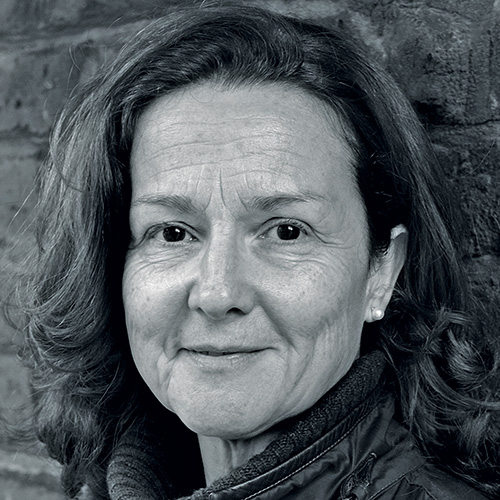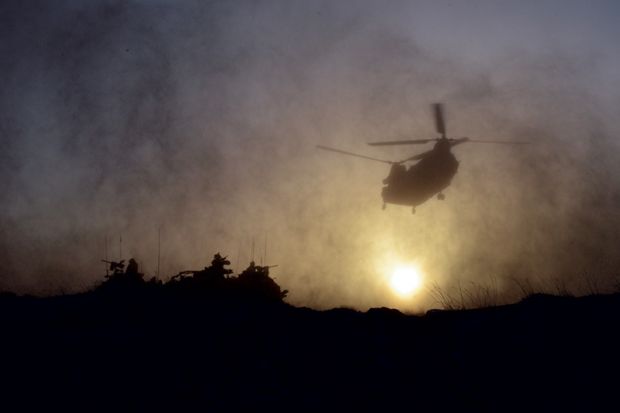On a visit to Helmand Province in April 2006, Defence Secretary John Reid insisted that British troops had been deployed to Afghanistan “to help and protect the Afghan people to reconstruct their economy and democracy”. He even claimed that “we would be perfectly happy to leave in three years’ time without firing one shot”.
His hopes were in vain. Between June and August that year, British soldiers expended around 450,000 rounds of small arms fire and 750 mortar rounds with the enemy. During the 13 years of the campaign, 9,500 British troops served in 137 bases in Helmand Province; 456 were killed; another 1,981 were wounded. It is estimated that 92,000 Afghans were killed, 26,000 of whom were civilians. Nearly 100,000 more were wounded. British involvement only ended in October 2014, when the Union Jack was lowered at the British Army base of Camp Bastion.
Emily Mayhew’s new book, A Heavy Reckoning: War, Medicine and Survival in Afghanistan and Beyond, is a eulogistic account of the medical management of British “warfighters” who were wounded in Afghanistan. Although she acknowledges that about 80 per cent of the personnel treated in military medical establishments there were Afghan, her primary interest lies with British casualties.
Mayhew is an expert on military medicine. Her first foray into this field came in 2010 when she published a book on reconstructive surgery during the First World War. However, her insights came to wider public attention in 2013 when she wrote a highly evocative book entitled Wounded, which emphasised the crucial role played by stretcher bearers (a job now carried out by the Medical Emergency Response Teams) between 1914 and 1918.
She is well placed to conduct such research. Based at Imperial College London, Mayhew has the grand title of historian in residence in the department of bioengineering, where she works with the Royal British Legion Centre for Blast Injury Studies. Her “insider status” has many advantages. She has access to wounded service personnel as well as to the medical professionals who care for them. She is able to translate their highly specialist surgical procedures into a language we can all understand. However, her position may also help explain her lack of interest in the geopolitical reasons for the carnage that she so carefully documents, as well as her rather starry-eyed accounts of heroic surgery and medico-military technologies.
By any standards, A Heavy Reckoning is not for the faint-hearted. It is a bloody book – as is right and proper. After all, wartime injuries are truly shocking. Most of the injuries she documents are caused by “improvised explosive devices” (IEDs), which Mayhew acknowledges are no longer “improvised” but mass-produced and distributed. IEDs tear bodies apart; the intensity of physiological shock inflicted is appalling. Blast waves not only pulverise muscle and bone but also burst eardrums, rupture the delicate membranes of the lungs and can perforate the gut, leading to sepsis.
Soldiers in active service have to learn to cope with the sight, sound and stench associated with terrible injuries. They have to learn to touch such wounds. Gauzes impregnated with haemostatic agents to slow the flow of blood have to be manually pressed into deep lacerations; tourniquets made of reinforced nylon need to be twisted above sites of amputations; analgesics for the inevitable pain require prompt application.
First aid carried out “in the field” is only the first step. Wounded soldiers have to be evacuated to hospitals behind the lines and, eventually, back to the UK. Indeed, the most disturbing part of Mayhew’s book is her argument that the suffering caused by war wounds may last a lifetime. Wounded soldiers age much faster than other people. Their risk of developing chronic health conditions such as hypertension, diabetes and heart disease is significantly higher than average.
Although the reasons for this heightened morbidity are not clear, some scientists suggest that it may be due to the “inflammatory response” of the body to severe trauma: the “inflammatory storm” that occurs when a person attempts to cope with sudden dismemberment does not immediately recede in its aftermath. What is left is a “chronic pro-inflammatory state”, prone to over-reaction. And then there are long-term ailments linked to specific types of injury. For example, 70 per cent of military amputees develop heterotopic ossification or HO. This is when a nerve or blood vessel or other soft tissue turns into bone. It is incredibly painful. For most British men and women who served in Afghanistan, the war did not end in 2014.
Mayhew is sensitive to the fact that the war had a long afterlife for the families of servicemen and women as well. Informing relatives that their loved one has been seriously injured is a heart-rending task, often necessitating careful management by a duty critical care nurse. His or her job is to prepare families in advance for what they will face when they enter the hospital ward. There is some humour. One soldier quipped, “Mother, you’re going to be taller than me again!” – but most of it is very grim indeed. Patients are often extremely agitated when they wake up from the anaesthetic. Those returning from the battlefield frequently have distorted memories of what happened: they sometimes believe that the masked people around them are enemy interrogators, preparing to torture them. They may rip out central venous lines, punch staff and attempt to escape. They may be in such severe and uncontrolled pain that they beg to be put out of their misery.
In Mayhew’s book, injured service personnel and their families are joined by a third group of men and women for whom war is an unmitigated evil. The medical professionals who care for the war wounded are themselves traumatised by what they are forced to witness on a daily basis. Military medical staff experience “burnout”, including psychological exhaustion, depersonalisation and other symptoms of post-traumatic stress disorder (PTSD). Mayhew became increasingly anxious when interviewing medical personnel who were clearly emotionally upset. She noted that her questions sometimes took them “somewhere where they were not masters of their memories”.
Her response was to stop asking them to speak to her. She also removed “all the material I got from them because it did not belong in a history book”. This is a strange and disconcerting comment. Why should trauma be excised from history? If we are to understand war – and understand why John Reid’s hope that British troops would not need to “fire one shot” seems so disingenuous – the unseen and often unacknowledged traumas of combat must be recorded and discussed.
Joanna Bourke is professor of history, Birkbeck, University of London and the author of Wounding the World: How the Military and War Games Invade Our Lives (2015).
A Heavy Reckoning: War, Medicine and Survival in Afghanistan and Beyond
By Emily Mayhew
Profile Books and the Wellcome Collection, 320pp, £16.99 and £12.99
ISBN 9781781255858 and 82832225 (e-book)
Published 25 May 2017

The author
Emily Mayhew, a “historian in residence” at Imperial College London, was brought up in East Sussex. This, she says, “had very specific relevance for what has become my work. All Sussex children are taught extensively about the Second World War because so much of it happened in the skies overhead. My grandmother had worked in a local hospital that treated the badly burned RAF aircrew from 1940, so I knew about the history from two specific points: the military and the medical.”
Although she went straight to work from school, Mayhew later embarked on a history degree with the Open University as a 40-year-old mature student. A module on the history of science, technology and medicine was taught at Imperial, so she picked up a leaflet about its MSc programme in history. That led to an MSc and then a PhD.
Even as a child, Mayhew knew “the story of the RAF’s Guinea Pig Club – a cohort of unexpected survivors of severe burns injury in the Second World War. For me, Spitfire engines equated with burns injury as much as the Battle of Britain itself. So that is always my analytical focus. Show me the wound, and I’ll tell you about the war in which it was inflicted: strategy, tactics, technology, medical practice, reconstruction, rehabilitation and attitudes to veterans. It’s a rich and useful analytical model.”
Although she does not claim “any particular authority” to comment on “foreign policy issues” or “the moral justifications of war”, Mayhew stresses that her research touches on some urgently practical issues: “Preparing to treat emergencies in the field should incorporate dealing with the consequences of those injuries for the casualty after the emergency is over. Military casualty is no longer a question of large-scale cohorts, but it is essentially about very long-term commitments. That’s the space in which my work has value, so that’s where I think I should be.”
Matthew Reisz
POSTSCRIPT:
Print headline: A close-up of military wounds
Register to continue
Why register?
- Registration is free and only takes a moment
- Once registered, you can read 3 articles a month
- Sign up for our newsletter
Subscribe
Or subscribe for unlimited access to:
- Unlimited access to news, views, insights & reviews
- Digital editions
- Digital access to THE’s university and college rankings analysis
Already registered or a current subscriber?




